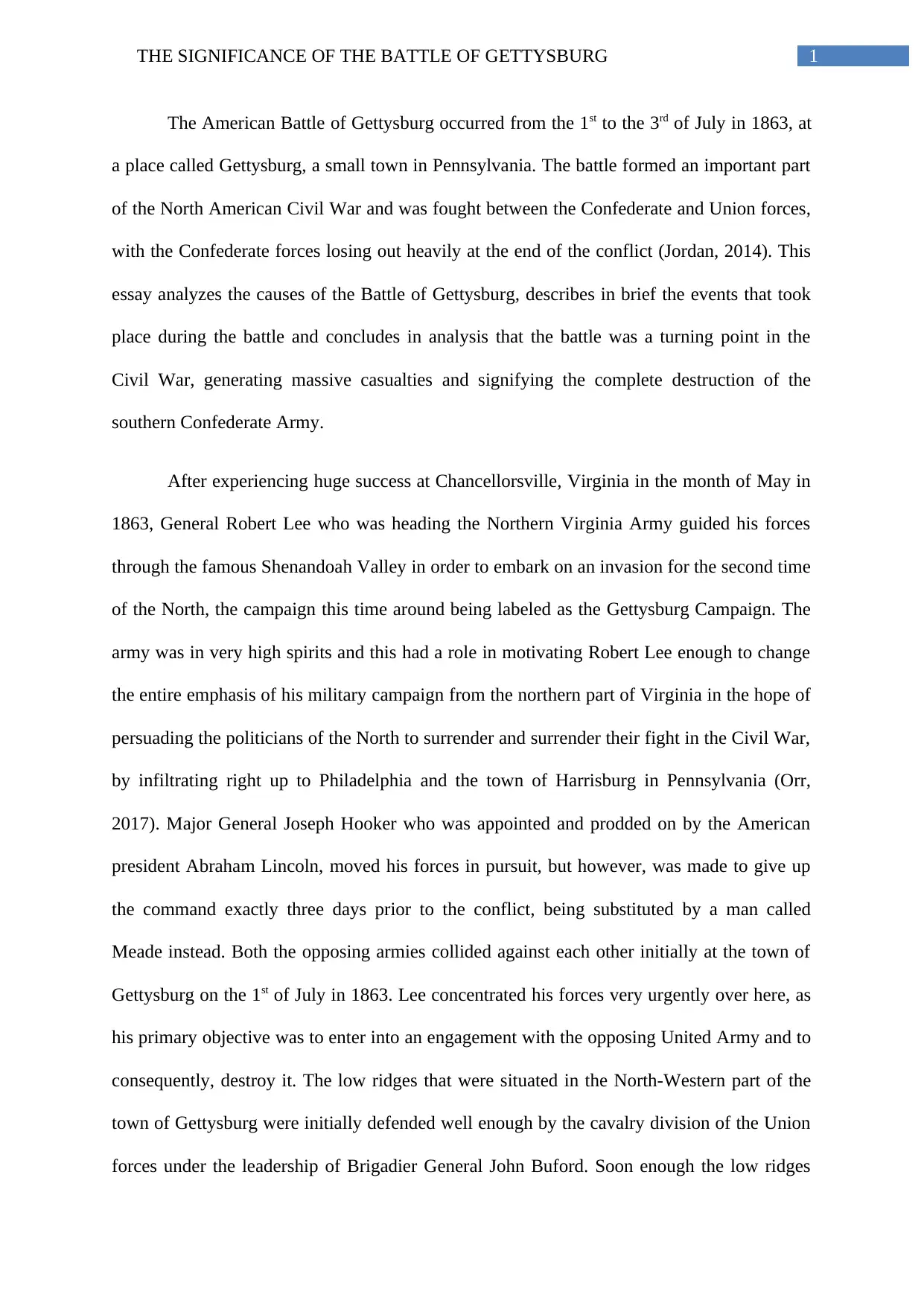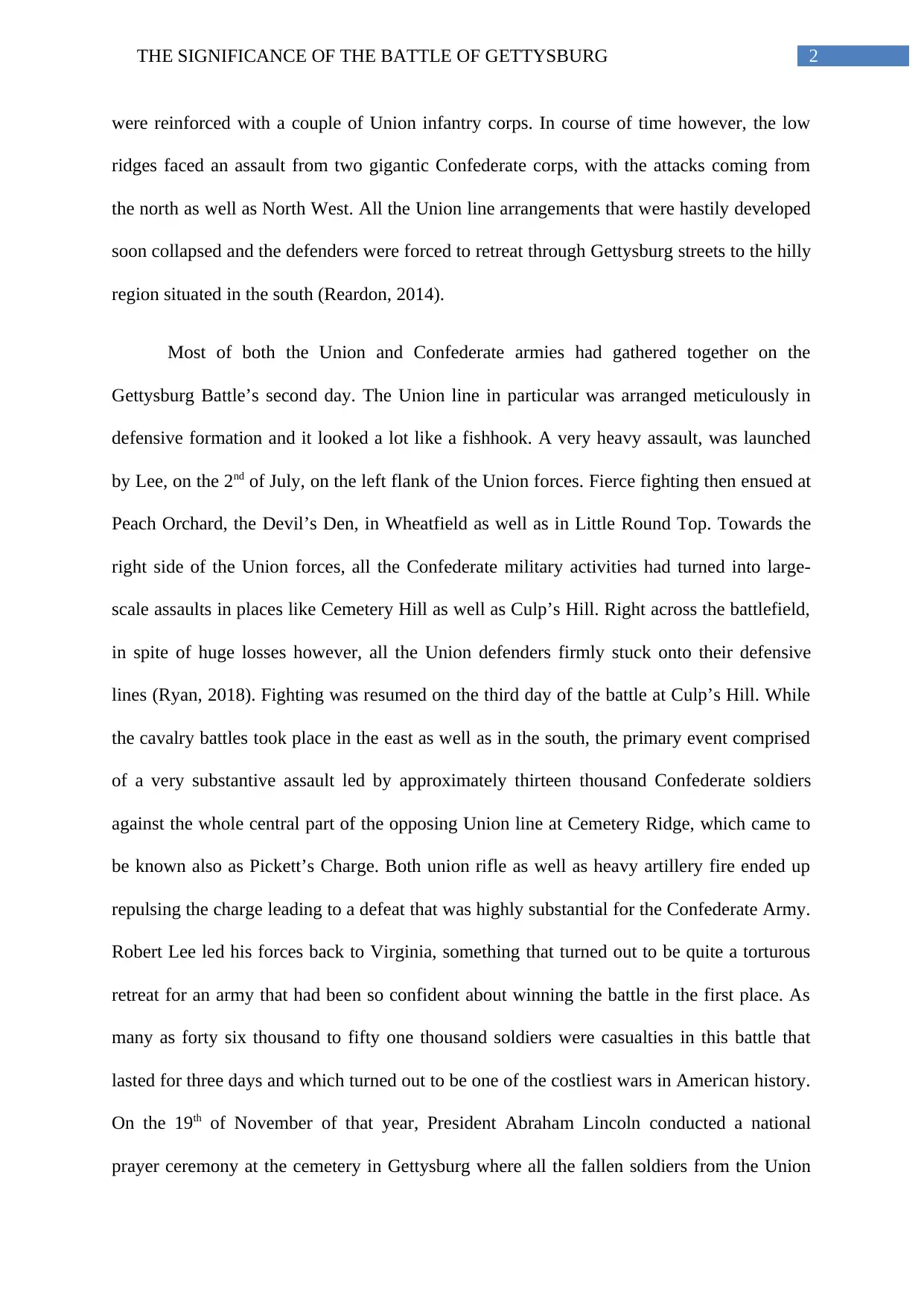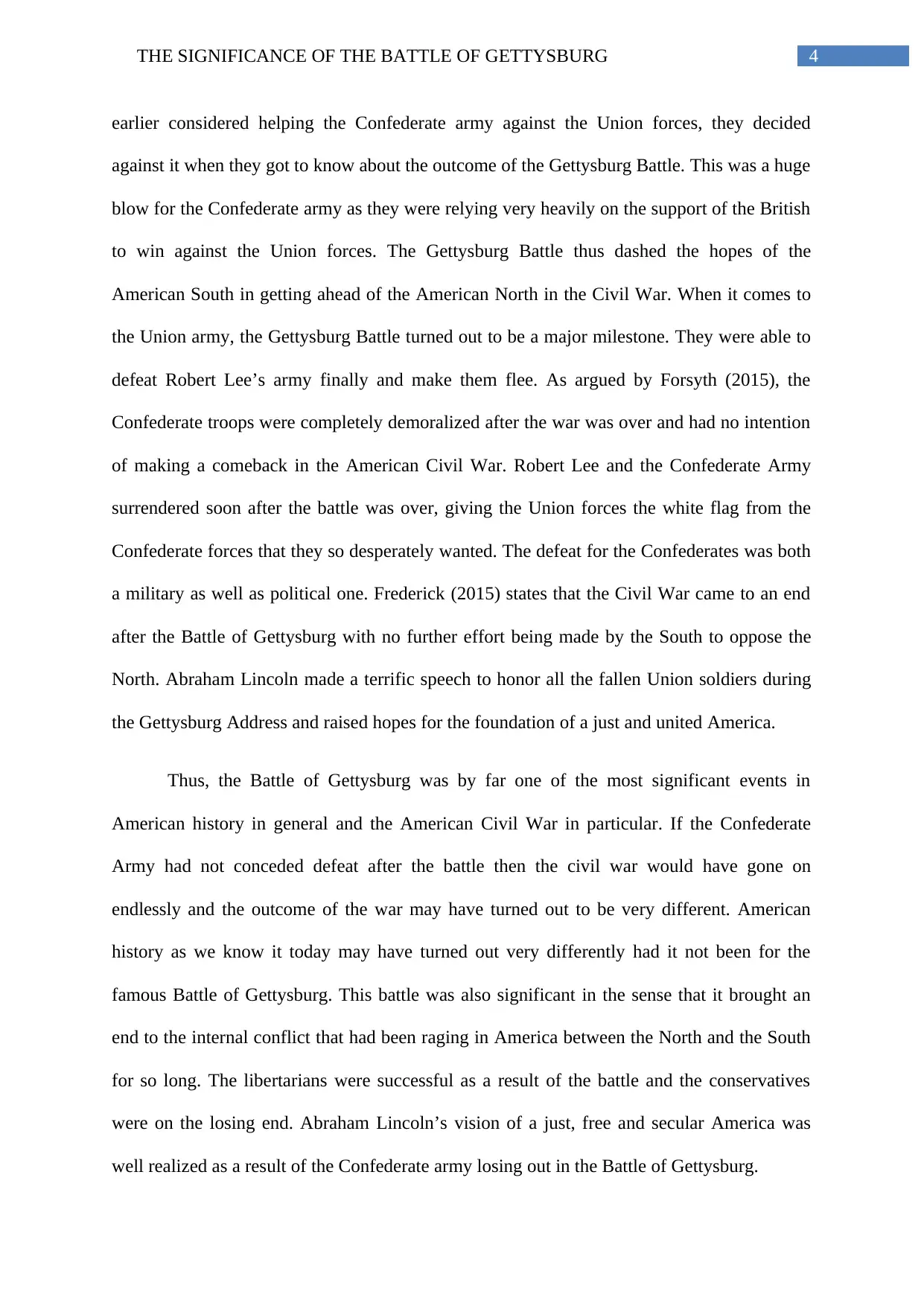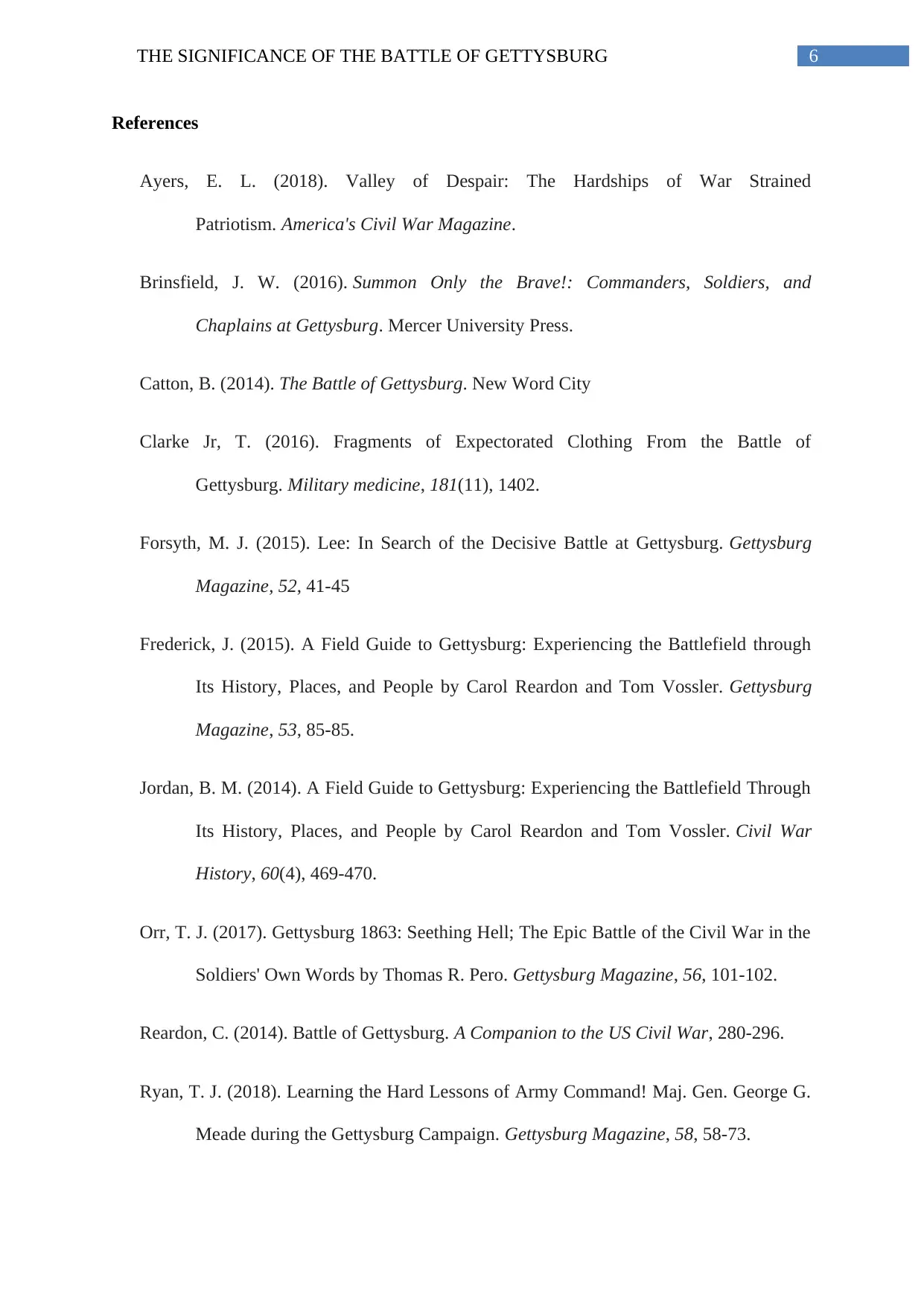The Significance of the Battle of Gettysburg: Causes and Impact
VerifiedAdded on 2023/06/04
|8
|2114
|85
Essay
AI Summary
This essay examines the Battle of Gettysburg, a crucial event in the American Civil War, fought from July 1st to 3rd, 1863. It details the causes leading up to the battle, including General Robert Lee's invasion of the North following Confederate successes. The essay recounts the three-day conflict, highlighting key moments such as Pickett's Charge and the Union's defensive strategies. It emphasizes the battle's immense casualties and its role as a turning point in the war, leading to the eventual demoralization and surrender of the Confederate Army. The essay also references Abraham Lincoln's Gettysburg Address and its impact on redefining the war's purpose and solidifying the vision of a united America. Ultimately, the Battle of Gettysburg marked the beginning of the end of the Civil War and the triumph of the Union cause.

Running Head: THE SIGNIFICANCE OF THE BATTLE OF GETTYSBURG
The Significance of the Battle of Gettysburg
Name of the Student
Name of the University
Author Note
The Significance of the Battle of Gettysburg
Name of the Student
Name of the University
Author Note
Paraphrase This Document
Need a fresh take? Get an instant paraphrase of this document with our AI Paraphraser

1THE SIGNIFICANCE OF THE BATTLE OF GETTYSBURG
The American Battle of Gettysburg occurred from the 1st to the 3rd of July in 1863, at
a place called Gettysburg, a small town in Pennsylvania. The battle formed an important part
of the North American Civil War and was fought between the Confederate and Union forces,
with the Confederate forces losing out heavily at the end of the conflict (Jordan, 2014). This
essay analyzes the causes of the Battle of Gettysburg, describes in brief the events that took
place during the battle and concludes in analysis that the battle was a turning point in the
Civil War, generating massive casualties and signifying the complete destruction of the
southern Confederate Army.
After experiencing huge success at Chancellorsville, Virginia in the month of May in
1863, General Robert Lee who was heading the Northern Virginia Army guided his forces
through the famous Shenandoah Valley in order to embark on an invasion for the second time
of the North, the campaign this time around being labeled as the Gettysburg Campaign. The
army was in very high spirits and this had a role in motivating Robert Lee enough to change
the entire emphasis of his military campaign from the northern part of Virginia in the hope of
persuading the politicians of the North to surrender and surrender their fight in the Civil War,
by infiltrating right up to Philadelphia and the town of Harrisburg in Pennsylvania (Orr,
2017). Major General Joseph Hooker who was appointed and prodded on by the American
president Abraham Lincoln, moved his forces in pursuit, but however, was made to give up
the command exactly three days prior to the conflict, being substituted by a man called
Meade instead. Both the opposing armies collided against each other initially at the town of
Gettysburg on the 1st of July in 1863. Lee concentrated his forces very urgently over here, as
his primary objective was to enter into an engagement with the opposing United Army and to
consequently, destroy it. The low ridges that were situated in the North-Western part of the
town of Gettysburg were initially defended well enough by the cavalry division of the Union
forces under the leadership of Brigadier General John Buford. Soon enough the low ridges
The American Battle of Gettysburg occurred from the 1st to the 3rd of July in 1863, at
a place called Gettysburg, a small town in Pennsylvania. The battle formed an important part
of the North American Civil War and was fought between the Confederate and Union forces,
with the Confederate forces losing out heavily at the end of the conflict (Jordan, 2014). This
essay analyzes the causes of the Battle of Gettysburg, describes in brief the events that took
place during the battle and concludes in analysis that the battle was a turning point in the
Civil War, generating massive casualties and signifying the complete destruction of the
southern Confederate Army.
After experiencing huge success at Chancellorsville, Virginia in the month of May in
1863, General Robert Lee who was heading the Northern Virginia Army guided his forces
through the famous Shenandoah Valley in order to embark on an invasion for the second time
of the North, the campaign this time around being labeled as the Gettysburg Campaign. The
army was in very high spirits and this had a role in motivating Robert Lee enough to change
the entire emphasis of his military campaign from the northern part of Virginia in the hope of
persuading the politicians of the North to surrender and surrender their fight in the Civil War,
by infiltrating right up to Philadelphia and the town of Harrisburg in Pennsylvania (Orr,
2017). Major General Joseph Hooker who was appointed and prodded on by the American
president Abraham Lincoln, moved his forces in pursuit, but however, was made to give up
the command exactly three days prior to the conflict, being substituted by a man called
Meade instead. Both the opposing armies collided against each other initially at the town of
Gettysburg on the 1st of July in 1863. Lee concentrated his forces very urgently over here, as
his primary objective was to enter into an engagement with the opposing United Army and to
consequently, destroy it. The low ridges that were situated in the North-Western part of the
town of Gettysburg were initially defended well enough by the cavalry division of the Union
forces under the leadership of Brigadier General John Buford. Soon enough the low ridges

2THE SIGNIFICANCE OF THE BATTLE OF GETTYSBURG
were reinforced with a couple of Union infantry corps. In course of time however, the low
ridges faced an assault from two gigantic Confederate corps, with the attacks coming from
the north as well as North West. All the Union line arrangements that were hastily developed
soon collapsed and the defenders were forced to retreat through Gettysburg streets to the hilly
region situated in the south (Reardon, 2014).
Most of both the Union and Confederate armies had gathered together on the
Gettysburg Battle’s second day. The Union line in particular was arranged meticulously in
defensive formation and it looked a lot like a fishhook. A very heavy assault, was launched
by Lee, on the 2nd of July, on the left flank of the Union forces. Fierce fighting then ensued at
Peach Orchard, the Devil’s Den, in Wheatfield as well as in Little Round Top. Towards the
right side of the Union forces, all the Confederate military activities had turned into large-
scale assaults in places like Cemetery Hill as well as Culp’s Hill. Right across the battlefield,
in spite of huge losses however, all the Union defenders firmly stuck onto their defensive
lines (Ryan, 2018). Fighting was resumed on the third day of the battle at Culp’s Hill. While
the cavalry battles took place in the east as well as in the south, the primary event comprised
of a very substantive assault led by approximately thirteen thousand Confederate soldiers
against the whole central part of the opposing Union line at Cemetery Ridge, which came to
be known also as Pickett’s Charge. Both union rifle as well as heavy artillery fire ended up
repulsing the charge leading to a defeat that was highly substantial for the Confederate Army.
Robert Lee led his forces back to Virginia, something that turned out to be quite a torturous
retreat for an army that had been so confident about winning the battle in the first place. As
many as forty six thousand to fifty one thousand soldiers were casualties in this battle that
lasted for three days and which turned out to be one of the costliest wars in American history.
On the 19th of November of that year, President Abraham Lincoln conducted a national
prayer ceremony at the cemetery in Gettysburg where all the fallen soldiers from the Union
were reinforced with a couple of Union infantry corps. In course of time however, the low
ridges faced an assault from two gigantic Confederate corps, with the attacks coming from
the north as well as North West. All the Union line arrangements that were hastily developed
soon collapsed and the defenders were forced to retreat through Gettysburg streets to the hilly
region situated in the south (Reardon, 2014).
Most of both the Union and Confederate armies had gathered together on the
Gettysburg Battle’s second day. The Union line in particular was arranged meticulously in
defensive formation and it looked a lot like a fishhook. A very heavy assault, was launched
by Lee, on the 2nd of July, on the left flank of the Union forces. Fierce fighting then ensued at
Peach Orchard, the Devil’s Den, in Wheatfield as well as in Little Round Top. Towards the
right side of the Union forces, all the Confederate military activities had turned into large-
scale assaults in places like Cemetery Hill as well as Culp’s Hill. Right across the battlefield,
in spite of huge losses however, all the Union defenders firmly stuck onto their defensive
lines (Ryan, 2018). Fighting was resumed on the third day of the battle at Culp’s Hill. While
the cavalry battles took place in the east as well as in the south, the primary event comprised
of a very substantive assault led by approximately thirteen thousand Confederate soldiers
against the whole central part of the opposing Union line at Cemetery Ridge, which came to
be known also as Pickett’s Charge. Both union rifle as well as heavy artillery fire ended up
repulsing the charge leading to a defeat that was highly substantial for the Confederate Army.
Robert Lee led his forces back to Virginia, something that turned out to be quite a torturous
retreat for an army that had been so confident about winning the battle in the first place. As
many as forty six thousand to fifty one thousand soldiers were casualties in this battle that
lasted for three days and which turned out to be one of the costliest wars in American history.
On the 19th of November of that year, President Abraham Lincoln conducted a national
prayer ceremony at the cemetery in Gettysburg where all the fallen soldiers from the Union
⊘ This is a preview!⊘
Do you want full access?
Subscribe today to unlock all pages.

Trusted by 1+ million students worldwide

3THE SIGNIFICANCE OF THE BATTLE OF GETTYSBURG
army were honored. The same event was used by the American president, to redefine war and
its purpose; an event that came to be known as the historic Gettysburg Address (Snell, 2016).
Out of all the different battles that the American Civil War was comprised of, the
Gettysburg Battle turned out to be bloodiest, generating the maximum number of casualties
and causing huge bloodshed. Historians of the American Civil War like Ayers (2018), believe
that this was a battle that was truly disturbing in character, with as many as fifty one thousand
soldiers having died in the battle on both sides. The goal of General Lee in the Gettysburg
Battle was to get the Union forces to come out and fight in the open in the hope that he and
his army would be able to out manouever them using better leadership skills. He considered
himself to be one of the best generals that ever lived and was arrogant enough to believe that
a loss of a few lives would not matter, and that the only thing which matter was defeating the
Union forces at any cost. In the midst of the battle, the Confederate forces got to hear about
there being a shoe factory in and around the war venue and since many of them did not have
shoes, they went to this shoe factory to get them. To their horror and dismay, they ran into the
Union forces upon doing so. According to Brinsfield (2016), what began as a skirmish, was
transformed into a vicious fight which lasted for three long days. The Pickett’s charge led by
more than twelve thousand men was the last and desperate attack on the part of the
Confederate army against the Union troops on the third and final day of the battle. The
Confederate army began marching towards the Union line only to be fired at by the Union
forces from all corners resulting in the death of more than ten thousand soldiers in just fifty
minutes. In the view of Catton (2014), General Robert Lee was forced to realize that he was
being outnumbered during different stages of the Gettysburg Battle but his inflated ego
prevented him from accepting defeat right until the very end, when he had no choice but to
concede defeat and failure to the Union army. According to Clarke (2016), the Confederate
army was unable to secure any foreign aid to help them win the battle. While the British had
army were honored. The same event was used by the American president, to redefine war and
its purpose; an event that came to be known as the historic Gettysburg Address (Snell, 2016).
Out of all the different battles that the American Civil War was comprised of, the
Gettysburg Battle turned out to be bloodiest, generating the maximum number of casualties
and causing huge bloodshed. Historians of the American Civil War like Ayers (2018), believe
that this was a battle that was truly disturbing in character, with as many as fifty one thousand
soldiers having died in the battle on both sides. The goal of General Lee in the Gettysburg
Battle was to get the Union forces to come out and fight in the open in the hope that he and
his army would be able to out manouever them using better leadership skills. He considered
himself to be one of the best generals that ever lived and was arrogant enough to believe that
a loss of a few lives would not matter, and that the only thing which matter was defeating the
Union forces at any cost. In the midst of the battle, the Confederate forces got to hear about
there being a shoe factory in and around the war venue and since many of them did not have
shoes, they went to this shoe factory to get them. To their horror and dismay, they ran into the
Union forces upon doing so. According to Brinsfield (2016), what began as a skirmish, was
transformed into a vicious fight which lasted for three long days. The Pickett’s charge led by
more than twelve thousand men was the last and desperate attack on the part of the
Confederate army against the Union troops on the third and final day of the battle. The
Confederate army began marching towards the Union line only to be fired at by the Union
forces from all corners resulting in the death of more than ten thousand soldiers in just fifty
minutes. In the view of Catton (2014), General Robert Lee was forced to realize that he was
being outnumbered during different stages of the Gettysburg Battle but his inflated ego
prevented him from accepting defeat right until the very end, when he had no choice but to
concede defeat and failure to the Union army. According to Clarke (2016), the Confederate
army was unable to secure any foreign aid to help them win the battle. While the British had
Paraphrase This Document
Need a fresh take? Get an instant paraphrase of this document with our AI Paraphraser

4THE SIGNIFICANCE OF THE BATTLE OF GETTYSBURG
earlier considered helping the Confederate army against the Union forces, they decided
against it when they got to know about the outcome of the Gettysburg Battle. This was a huge
blow for the Confederate army as they were relying very heavily on the support of the British
to win against the Union forces. The Gettysburg Battle thus dashed the hopes of the
American South in getting ahead of the American North in the Civil War. When it comes to
the Union army, the Gettysburg Battle turned out to be a major milestone. They were able to
defeat Robert Lee’s army finally and make them flee. As argued by Forsyth (2015), the
Confederate troops were completely demoralized after the war was over and had no intention
of making a comeback in the American Civil War. Robert Lee and the Confederate Army
surrendered soon after the battle was over, giving the Union forces the white flag from the
Confederate forces that they so desperately wanted. The defeat for the Confederates was both
a military as well as political one. Frederick (2015) states that the Civil War came to an end
after the Battle of Gettysburg with no further effort being made by the South to oppose the
North. Abraham Lincoln made a terrific speech to honor all the fallen Union soldiers during
the Gettysburg Address and raised hopes for the foundation of a just and united America.
Thus, the Battle of Gettysburg was by far one of the most significant events in
American history in general and the American Civil War in particular. If the Confederate
Army had not conceded defeat after the battle then the civil war would have gone on
endlessly and the outcome of the war may have turned out to be very different. American
history as we know it today may have turned out very differently had it not been for the
famous Battle of Gettysburg. This battle was also significant in the sense that it brought an
end to the internal conflict that had been raging in America between the North and the South
for so long. The libertarians were successful as a result of the battle and the conservatives
were on the losing end. Abraham Lincoln’s vision of a just, free and secular America was
well realized as a result of the Confederate army losing out in the Battle of Gettysburg.
earlier considered helping the Confederate army against the Union forces, they decided
against it when they got to know about the outcome of the Gettysburg Battle. This was a huge
blow for the Confederate army as they were relying very heavily on the support of the British
to win against the Union forces. The Gettysburg Battle thus dashed the hopes of the
American South in getting ahead of the American North in the Civil War. When it comes to
the Union army, the Gettysburg Battle turned out to be a major milestone. They were able to
defeat Robert Lee’s army finally and make them flee. As argued by Forsyth (2015), the
Confederate troops were completely demoralized after the war was over and had no intention
of making a comeback in the American Civil War. Robert Lee and the Confederate Army
surrendered soon after the battle was over, giving the Union forces the white flag from the
Confederate forces that they so desperately wanted. The defeat for the Confederates was both
a military as well as political one. Frederick (2015) states that the Civil War came to an end
after the Battle of Gettysburg with no further effort being made by the South to oppose the
North. Abraham Lincoln made a terrific speech to honor all the fallen Union soldiers during
the Gettysburg Address and raised hopes for the foundation of a just and united America.
Thus, the Battle of Gettysburg was by far one of the most significant events in
American history in general and the American Civil War in particular. If the Confederate
Army had not conceded defeat after the battle then the civil war would have gone on
endlessly and the outcome of the war may have turned out to be very different. American
history as we know it today may have turned out very differently had it not been for the
famous Battle of Gettysburg. This battle was also significant in the sense that it brought an
end to the internal conflict that had been raging in America between the North and the South
for so long. The libertarians were successful as a result of the battle and the conservatives
were on the losing end. Abraham Lincoln’s vision of a just, free and secular America was
well realized as a result of the Confederate army losing out in the Battle of Gettysburg.

5THE SIGNIFICANCE OF THE BATTLE OF GETTYSBURG
⊘ This is a preview!⊘
Do you want full access?
Subscribe today to unlock all pages.

Trusted by 1+ million students worldwide

6THE SIGNIFICANCE OF THE BATTLE OF GETTYSBURG
References
Ayers, E. L. (2018). Valley of Despair: The Hardships of War Strained
Patriotism. America's Civil War Magazine.
Brinsfield, J. W. (2016). Summon Only the Brave!: Commanders, Soldiers, and
Chaplains at Gettysburg. Mercer University Press.
Catton, B. (2014). The Battle of Gettysburg. New Word City
Clarke Jr, T. (2016). Fragments of Expectorated Clothing From the Battle of
Gettysburg. Military medicine, 181(11), 1402.
Forsyth, M. J. (2015). Lee: In Search of the Decisive Battle at Gettysburg. Gettysburg
Magazine, 52, 41-45
Frederick, J. (2015). A Field Guide to Gettysburg: Experiencing the Battlefield through
Its History, Places, and People by Carol Reardon and Tom Vossler. Gettysburg
Magazine, 53, 85-85.
Jordan, B. M. (2014). A Field Guide to Gettysburg: Experiencing the Battlefield Through
Its History, Places, and People by Carol Reardon and Tom Vossler. Civil War
History, 60(4), 469-470.
Orr, T. J. (2017). Gettysburg 1863: Seething Hell; The Epic Battle of the Civil War in the
Soldiers' Own Words by Thomas R. Pero. Gettysburg Magazine, 56, 101-102.
Reardon, C. (2014). Battle of Gettysburg. A Companion to the US Civil War, 280-296.
Ryan, T. J. (2018). Learning the Hard Lessons of Army Command! Maj. Gen. George G.
Meade during the Gettysburg Campaign. Gettysburg Magazine, 58, 58-73.
References
Ayers, E. L. (2018). Valley of Despair: The Hardships of War Strained
Patriotism. America's Civil War Magazine.
Brinsfield, J. W. (2016). Summon Only the Brave!: Commanders, Soldiers, and
Chaplains at Gettysburg. Mercer University Press.
Catton, B. (2014). The Battle of Gettysburg. New Word City
Clarke Jr, T. (2016). Fragments of Expectorated Clothing From the Battle of
Gettysburg. Military medicine, 181(11), 1402.
Forsyth, M. J. (2015). Lee: In Search of the Decisive Battle at Gettysburg. Gettysburg
Magazine, 52, 41-45
Frederick, J. (2015). A Field Guide to Gettysburg: Experiencing the Battlefield through
Its History, Places, and People by Carol Reardon and Tom Vossler. Gettysburg
Magazine, 53, 85-85.
Jordan, B. M. (2014). A Field Guide to Gettysburg: Experiencing the Battlefield Through
Its History, Places, and People by Carol Reardon and Tom Vossler. Civil War
History, 60(4), 469-470.
Orr, T. J. (2017). Gettysburg 1863: Seething Hell; The Epic Battle of the Civil War in the
Soldiers' Own Words by Thomas R. Pero. Gettysburg Magazine, 56, 101-102.
Reardon, C. (2014). Battle of Gettysburg. A Companion to the US Civil War, 280-296.
Ryan, T. J. (2018). Learning the Hard Lessons of Army Command! Maj. Gen. George G.
Meade during the Gettysburg Campaign. Gettysburg Magazine, 58, 58-73.
Paraphrase This Document
Need a fresh take? Get an instant paraphrase of this document with our AI Paraphraser

7THE SIGNIFICANCE OF THE BATTLE OF GETTYSBURG
Snell, M. A. (2016). My Gettysburg: Meditations on History and Place. The Kent State
University Press.
Snell, M. A. (2016). My Gettysburg: Meditations on History and Place. The Kent State
University Press.
1 out of 8
Your All-in-One AI-Powered Toolkit for Academic Success.
+13062052269
info@desklib.com
Available 24*7 on WhatsApp / Email
![[object Object]](/_next/static/media/star-bottom.7253800d.svg)
Unlock your academic potential
Copyright © 2020–2025 A2Z Services. All Rights Reserved. Developed and managed by ZUCOL.

